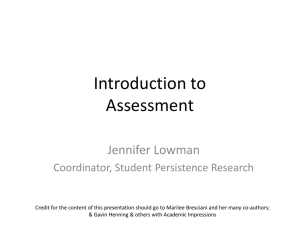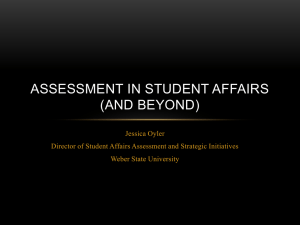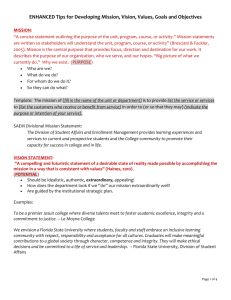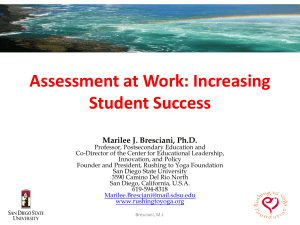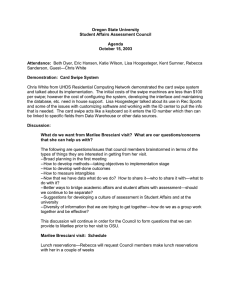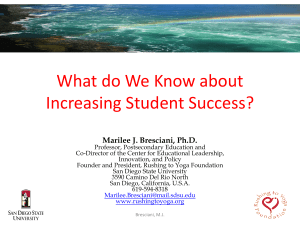Assessing and Accountability in Student Affairs Marilee J. Bresciani, Ph.D.
advertisement
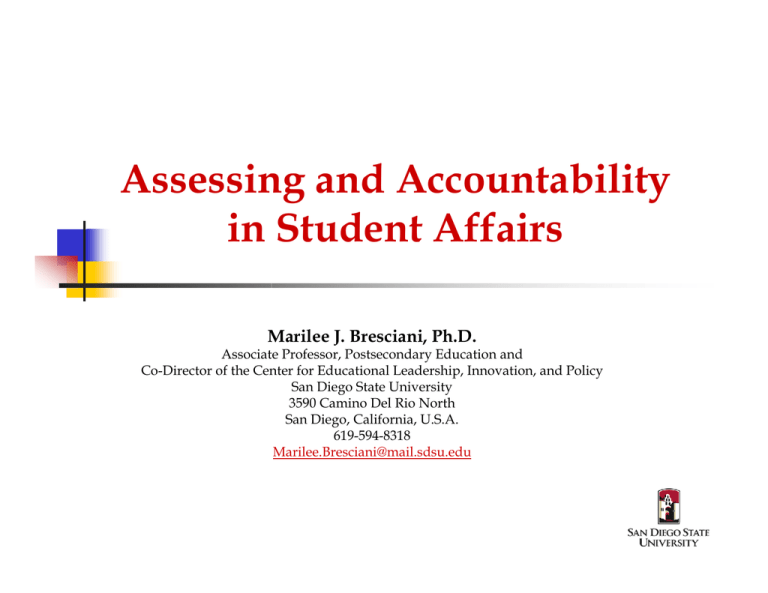
Assessing and Accountability in Student Affairs Marilee J. Bresciani, Ph.D. Associate Professor, Postsecondary Education and Co-Director of the Center for Educational Leadership, Innovation, and Policy San Diego State University 3590 Camino Del Rio North San Diego, California, U.S.A. 619-594-8318 Marilee.Bresciani@mail.sdsu.edu Presentation Overview Overview of Outcomes-Based Assessment (OBA) Importance of OBA What is Required? Break Components of Assessing Student Learning and Development Questions Bresciani, M.J. Ask Yourself These Questions What decision did you make about your program last year? What evidence did you use to inform that decision? What was it that you were trying to influence about your program when making that decision with the stated evidence? Bresciani, M.J. That is Outcomes-Based Assessment Most people do capitalize on their innate intellectually curiosity to find out what works Most people just don’t articulate their intended end results (e.g., outcomes) ahead of time Most people don’t document the decisions made based on their results Most people don’t follow up later to see if their decisions made the intended improvement Bresciani, M.J. The Assessment Cycle (Bresciani, 2003) The key questions… • • • • • • What are we trying to do and why? or What is my program supposed to accomplish? How well are we doing it? How do we know? How do we use the information to improve or celebrate successes? Do the improvements we make work? Bresciani, M.J. The Iterative Systematic Assessment Cycle Gather Data Interpret Evidence Adapted from Peggy Maki, Ph.D. by Marilee J. Bresciani, Ph.D. Mission/Purposes Goals Outcomes Implement Methods to Deliver Outcomes and Methods to Gather Data Make decisions to improve programs; enhance student learning and development; inform institutional decisionmaking, planning, budgeting, policy, public accountability Assessment ( Bresciani et alia, 2006) Most importantly, it should be Understood = by professionals and students Inclusive = involve as many professionals as possible Meaningful = professional (i.e., expert) driven Manageable = takes into account varying resources Flexible = takes into account assessment learning curves Truth-seeking/objective/ethical Iterative and systematic Inform decisions for continuous improvement or provides evidence of proof Promote a culture of accountability, of learning, and of improvement Bresciani, M.J. What are you already doing that could be considered outcomesbased assessment? Why is outcomes-based assessment important? The Purpose Outcomes-Based assessment does not exist for assessment’s sake It is taking what most of us already do, and making it systematic It is NOT personnel evaluation Bresciani, M.J. The Purpose, Cont. Its purpose is to reflect on the end result of doing - - are we accomplishing that which we say we are? All types of assessment have value (e.g., needs, utilization, satisfaction, learning and development) but we have to pay attention to evaluating student learning Bresciani, M.J. Purpose of Assessment, Cont. (Bresciani et alia, 2004) 1) Reinforce or emphasize the mission of your unit 2) Improve programs and/or performance (formative) 3) Compare a program’s quality or value to the program’s previously defined principles (summative) 4) Inform planning 5) Inform decision making Bresciani, M.J. Purpose of Assessment, Cont. (Bresciani et alia, 2004) 6) Inform policy discussions at the local, state, regional, and national level 7) Evaluate programs, not personnel 8) Assist in the request for additional funds from the University and external community 9) Assist in the re-allocation of resources 10) Assist in meeting accreditation requirements, models of best practices, and national benchmarks Bresciani, M.J. Purpose of Assessment, Cont. (Bresciani et alia, 2004) 12) Celebrate successes 13) Manage expectations 14) Reflect on the attitudes and approach we take in improving teaching and learning 15) Create a culture of continuous improvement – a culture of accountability, of learning, and of improvement Bresciani, M.J. Drivers of Outcomes-Based Assessment (Ewell, 2001) To improve the underperforming student • Competency Movement in Business and Industry • International Trade Agreements • Affecting higher Education - Competition for new providers in Postsecondary or Tertiary Education • Transnational Education or Globalism • Massification of Education Bresciani, M.J. Drivers, Cont. Bologna Declaration of 1999 Government Conversation, 1985 The Higher Education Re-authorization Act Testimonies in USA, 2002 and 2006 Response to NCLB Legislation Regional Accreditation – flexibility CRAC – 2003, 2004 Both documents focus on student learning Bresciani, M.J. Drivers, Cont. National Commission on the Future of Higher Education •Demand for Public Information about Performance •Transparency of outcomes and results •Comparable measures of quality •Demonstration of value-added of the entire educational experience Bresciani, M.J. Drivers, Cont. Other Research on Collaborative/Integrated Learning •NSSE Deep Learning Project •Wabash Institute •Alverno College •National Research Council •AAC&U Greater Expectations •NASPA/ACPA Learning Reconsidered Bresciani, M.J. What purposes or drivers appeal to you and/or your peers? So, what is required? Well… (insert technical disclaimer) Required? Comprehensive, systematic evaluation of student learning and development Integrated conversations of what is working and what is not Emphasis on how the data was used to improve student learning An ability to state clearly what is being learned and what is not Eventually, Comparable indicators of learning and development but only if you can link them back to intended learning and development Demonstration of value-added of the entire educational experience, not just one program Bresciani, M.J. The Focus on Assessing Student Learning “The concepts of learning, personal development, and student development are inextricably intertwined and inseparable.” – The Student Learning Imperative The Importance of Student Learning “It is important for student development professionals to inform the academic side of the institution of their desire to establish, maintain, and assess functional collaborations. Among these should be collaborations that promote measurable student learning promote student engagement and socio-academic integration provide training to student affairs staff about learning environments and learning outcomes.” -James A. Anderson Bresciani, M.J. Some Questions about Student Learning and Development What do you expect your students to know and be able to do by the end of their education at your institution? What do the curricula and the cocurricular “add up to?” What do you do in your programs to promote the kinds of learning and development that your institution seeks? Bresciani, M.J. Some More Questions Which students benefit from which co-curricular experiences? What co-curricular processes are responsible for the intended student outcomes the institution seeks? How can you help students make connections between classroom learning and experiences outside of the classroom? How do you intentionally build upon what each of you fosters to achieve? Bresciani, M.J. Questions that Direct the Development of Synergy between Academic Affairs and Student Affairs James A. Anderson, Ph.D. What is the thinking task, intellectual experience, and/or co-curricula experience that needs to be designed relative to the preparation level and diversity of the students at your institution? Can the interpersonal transactions that occur in the everyday life of the student and that reflect cultural orientations serve as a basis for potential new models of critical thinking? What curricular experiences will promote this skill development? Bresciani, M.J. Questions that Direct the Development of Synergy between Academic Affairs and Student Affairs Continued James A. Anderson, Ph.D. What structures need to evolve to assure that students have the opportunity to enhance academic self-concept and understand their role in the culture of learning at your institution? Bresciani, M.J. Reflection Questions How are you directly or indirectly contributing to student learning? How are you directly or indirectly supporting student learning? How are you directly or indirectly interfering with student learning? Bresciani, M.J. Break Continue with Steps in Evaluating Student Learning and Development Typical Components of An Outcomes-Based Assessment Plan (Bresciani, 2006) Program Name Program Mission or Purpose Goals Outcomes Student Learning and program Planning for Delivery of Outcomes Align with your strategic plan, college goals, division goals, or department goals Concept Mapping Your strategic plan objectives Evaluation Methods With criteria for each outcomes Add Limitations, if necessary Link to Division Indicators Bresciani, M.J. Typical Components of An Outcomes-Based Assessment Plan, Cont. Implementation of Assessment Process Identify who is responsible for doing each step in the evaluation process (list all of the people involved in the assessment process at each step of the process) Outline the timeline for implementation Identify who will be evaluated Identify other programs who are assisting with the evaluation Identify who will be participating in interpreting the data and making recommendations and decisions Bresciani, M.J. Typical Components of An Outcomes-Based Assessment Report Program Name Outcomes Results Summarize the results for each outcome Summarize the process to verify/validate the results Decisions and Recommendations Summarize the decisions/recommendations made for each outcome Bresciani, M.J. Typical Components of An Outcomes-Based Assessment Report, Cont. Decisions and Recommendations, Cont. Identify the groups who participated in the discussion of the evidence that led to the recommendations and decisions Summarize the suggestions for improving the assessment process Identify when each outcome will be evaluated again (if the outcome is to be retained) Identify those responsible for implementing the recommended changes Bresciani, M.J. Which steps do you already have in place? Mission Statement “In just a few sentences, a mission statement needs to communicate the essence of your organization to your stakeholders and to the general public.” - Fund Raising Made Simple It can come from your strategic planning initiatives or from your Division, institution, or unit plan It can also come from your professional organization (e.g., ACUHO-I, ACU-I, CAS) Bresciani, M.J. Goals They are broad, general statements of [1] what the program wants students to be able to do and to know or [2] what the program will do to ensure what students will be able to do and to know. They are evaluated directly or indirectly by measuring specific outcomes related to the objective. They are related to the mission and objectives of the department and college in which the program resides, and to the mission and objectives of the University. Bresciani, M.J. Example Program Goal To provide students with opportunities to develop their leadership skills Bresciani, M.J. Other Examples 1. Expand the academic emphasis in the residence halls 2. To encourage life long learning 3. Students will appreciate their diverse environment 4. Students will learn sound study skills Bresciani, M.J. Other Examples, Cont. To provide students with opportunities to develop their communication skills. To provide students with opportunities to develop ethical decision making systems. To provide students with opportunities to develop global and cultural awareness. Bresciani, M.J. Other Examples, Cont. To provide quality services To provide responsive services To provide excellent customer service To be attentive to parental requests Bresciani, M.J. Ask these Questions about your Goals Is it meaningful? Is it important? Is it a broad, general statement of either what the program wants students to be able to do and to know or what the program will do to ensure what students will be able to do and to know? Is it related to my department or program mission and objectives? Is there an accompanying outcome to measure this objective? Bresciani, M.J. Write Down or Refine an Appropriate Goal for Your Program Outcomes Outcomes are more detailed and specific statements derived from the goals. These are specifically about what you want the end result of your efforts to be. It is not what you are going to do to the student, but rather it describes how you want the student to demonstrate what he or she knows or can do. They use active verbs such as articulate, illustrate, conduct, synthesize, analyze, etc. Bresciani, M.J. Additional Assistance Constructing Learning Outcomes: Bloom’s Taxonomy http://www.teachers.ash.org.au/researchski lls/dalton.htm http://www.kent.wednet.edu/KSD/MA/res ources/blooms/teachers_blooms.html http://www.coun.uvic.ca/learn/program/h ndouts/bloom.html Terms: construct, locate, dissect, categorize, compose, invent….. Outcomes, Cont. Make a conscious decision to articulate outcomes that infer pre- and post-tests Make a conscious decision to be held responsible for behavior Remember that your outcomes may look different for your various constituents - - you may want to start with your more manageable population first, such as your Para-professionals Bresciani, M.J. Outcomes, Cont. Regardless of whether your goals are top down – the outcome is where you operationalize the goal. Therefore, the outcome or end result of the doing allows you to “personalize” the goal to your own program. Bresciani, M.J. Example Outcome Students will demonstrate responsible leadership by organizing a successful event that their group’s membership deems important and relevant to the residential community . Bresciani, M.J. Examples of Outcomes, Cont. 1. 2. 3. Students will be able to compare and contrast various leadership styles. Students will be able to locate all of the items they need for a balanced diet. Students will demonstrate care when using the recreation center equipment. Bresciani, M.J. Other Example Outcomes 1. Resident advisors will apply conflict resolution skills in halls. 2. Resident advisors will facilitate the steps in decision making among residents who demonstrate an inability to make responsible choices. 3. Facilities experts will respond to work order requests within 24 hours of completed filing. Bresciani, M.J. Other Example Outcomes Students who are greeted at the front counter will report that they received accurate information delivered in a friendly manner. Students who read the monthly newsletter report that it contains accurate and timely information. Bresciani, M.J. Questions to Ask Yourself About Outcomes Is it measurable/identifiable? Is it meaningful? Is it manageable? Who is the target audience of my outcome? Who would know if my outcome has been met? How will I know if it has been met? Will it provide me with evidence that will lead me to make a decision for continuous improvement? Bresciani, M.J. Articulate your Outcomes: Refine At Least One of Your Outcomes After you have articulated your outcomes… Make sure You have a program that can actually deliver the outcome e.g., planning Before Choosing an Assessment Method… Think about what meeting the outcome looks like Be sure to describe the end result of the outcome by using active verbs This helps articulate the criteria for identifying when the outcome has been met Describe how your program is delivering the outcome There may be clues in the delivery of the outcome that help you determine how to evaluate it Bresciani, M.J. Before Choosing an Assessment Method, Cont. Think about collecting data from different sources to make more meaningful and informed decisions for continuous improvement (e.g., surveys, observations, selfassessment) and for triangulation of data that you believe will be useful in answering the important questions you have raised that will appeal to your primary constituents or to those with whom you are trying to influence Bresciani, M.J. Measurement Methods (Palomba and Banta, 1999) Evidence of learning- basically two types Direct-methods of collecting information that require the students to display their knowledge and skills Indirect- methods that ask students or some one else to reflect on the student learning rather than to demonstrate it Bresciani, M.J. Another Way to Look at It (Ewell, 2003) There are naturally occurring assessment techniques (e.g. projectembedded assessment methods such as essays, observed behavior, student interactions, student debates) There are those designed as a means to evaluate (e.g., surveys) Bresciani, M.J. Some Methods That Provide Direct Evidence Student work samples Collections of student work (e.g. Portfolios) Capstone projects Project-embedded assessment Course-embedded assessment Observations of student behavior Internal juried review of student projects External evaluations of student performance Document analysis (e.g., meeting minutes, policies, handbooks) Bresciani, M.J. Direct Evidence Cont. from Peggy Maki, Ph.D. External juried review of student projects Externally reviewed internship Performance on a case study/problem Performance on problem and analysis (Student explains how he or she solved a problem) Performance on national licensure examinations Locally developed tests Standardized tests Pre-and post-tests Essay tests blind scored across units Bresciani, M.J. Some Methods That Provide Indirect Evidence adapted from Peggy Maki, Ph.D. Alumni, Employer, Student Surveys Focus groups (depending on the interview protocol, this could be used as direct evidence) Exit Interviews with Graduates Graduate Follow-up Studies Percentage of students who go on to graduate school Retention and Transfer Studies Job Placement Statistics Bresciani, M.J. Indirect Evidence Cont. Faculty/Student ratios Percentage of students who study abroad Enrollment trends Percentage of students who graduate within five-six years Diversity of student body CAS Standards Bresciani, M.J. Choosing A Tool It is important to choose tools based on what you are trying to assess, not on what tool is most appealing to you Consider what will influence your constituents Consider what will provide you with information to make decisions Be able to justify your choice of tool and method Bresciani, M.J. Things to Consider When Choosing an Instrument What outcome(s) are you measuring? What criteria will determine if the outcome is met? Who is being assessed? How often do I have access to them? Do I know who they are? What is my budget? What is my timeline? What type of data is most meaningful to me: direct/indirect and qualitative/quantitative Bresciani, M.J. Things to Consider, Cont. Who will analyze the data and how? Who needs to see this data? How easily can I fit this method into my regular responsibilities? (every day, week, semester, year) Who needs to make decisions with this data? How will I document the evidence and the decisions made from that evidence? Bresciani, M.J. Example Outcomes Revisited Students will be able to articulate the steps of ethical decision making Students will be able to identify the challenges to making ethical choices (via case studies) Students will be able to evaluate their own choices and identify where they excelled in their own ethical decision making (via journals) Bresciani, M.J. Possible Assessment Tools Quiz Essay Journal Case Study Observation Peer Evaluation with criteria or rubric Professional Evaluation with criteria or rubric Bresciani, M.J. Choose an Outcome and Work through this Process Questions to Ask About Choosing a Measurement Tool How is this outcome delivered/implemented? What is my budget? What is my timeline? What are my analysis capabilities? Who needs to see this data? How easily can I fit this method into my annual responsibilities? Who needs to make decisions with this data? Will this kind of evidence help me make the decisions I need to make? How will I document the evidence and the Bresciani, M.J. decisions made from that evidence? Re-Casting Services In some cases, you may need to re-cast your services so that you can provide that which delivers the end result or provides the opportunities to assess student development and learning. Or you may just need to sit down and articulate the criteria that describes that which you want the student to demonstrate (i.e. What does problem solving look like?) Bresciani, M.J. If You are Still Having Trouble… Diagram or map which activity, program, project, or workshop is delivering or is producing each intended outcome. Once you have identified how you are delivering each outcome, you can list out the activities and literally map them to the outcomes, which they are delivering. Bresciani, M.J. An Example of an Outcome Delivery Map Activity/Project/Workshop 1 Outcome 1 Outcome 2 Outcome 3 Etc. Bresciani, M.J. Activity/Project/Workshop 2 Etc. Etc. Closing the Assessment Loop Briefly report methodology for each outcome Document where the students are meeting the intended outcome Document where they are not meeting the outcome Document decisions made to improve the program and assessment plan Refine assessment method and repeat process after proper time for implementation Bresciani, M.J. Reporting Strategies from Gary Hanson, Ph.D. Know your data Know your audience Tell the story Identify meaningful indicators to shape the story Examine indicators for patterns Begin with the end in mind Involve the end users in the process Bresciani, M.J. What to Do with Your Mounds of Data? After you have articulated your outcomes, you can sift through the mounds of data more readily to determine what information can help you. Don’t be surprised if you don’t find any pre-existing data that will help you determine the effectiveness of your program. Bresciani, M.J. What to Do with Your Mounds of Data?, Cont. Most benchmark instruments help you identify where you are doing well and where you may have problems. That helps you prioritize your assessment work, but it may not help you with decisions for improving your program or for informing policy. Bresciani, M.J. Take-Home Messages You do not have to assess everything you do every year. You don’t have to do everything at once-start with 2 or 3 learning outcomes Think baby steps Be flexible Acknowledge and use what you have already done. Assessment expertise is available to help - -not to evaluate your program Borrow examples from other institutions to modify as appropriate Time for this must be re-allocated We allocate time according to our priorities Resources Each Other NASPA and ACPA University Planning and Analysis (UPA) Assessment website http://www2.acs.ncsu.edu/UPA/assmt/ Higher Learning Commission Website http://www.ncahigherlearningcommission.org/ Bresciani, M.J. Questions? One Minute Evaluation What is the most valuable lesson that you learned from this workshop? What is one question that you still have? What do you think is the next step that your division/program needs to take in order to implement systematic program assessment? Bresciani, M.J. References Bresciani, M.J. (September, 2002). The relationship between outcomes, measurement. and decisions for continuous improvement. National Association for Student Personnel Administrators, Inc NetResults E-Zine. http://www.naspa.org/netresults/index.cfm Bresciani, M.J., Zelna, C.L., and Anderson, J.A. (2004). Techniques for Assessing Student Learning and Development in Academic and Student Support Services. Washington D.C.:NASPA. Ewell, P. T. (2003). Specific Roles of Assessment within this Larger Vision. Presentation given at the Assessment Institute at IUPUI. Indiana University-Purdue University- Indianapolis. Maki, P. (2001). Program review assessment. Presentation to the Committee on Undergraduate Academic Review at NC State University. References, Cont. Bresciani, MJ. (2006). Outcomes-Based Undergraduate Academic Program Review: A Compilation of Institutional Good Practices. Sterling, VA: Stylus Publications. NC State University, Undergraduate Academic Program Review. (2001) Common Language for Assessment. Taken from the World Wide Web September 13, 2003: http://www.ncsu.edu/provost/academic_programs/uapr/proce ss/language.html Palomba, C.A. and Banta, T.W. (1999). Assessment essentials: Planning, implementing and improving assessment in Higher Education. San Francisco: Jossey-Bass. University of Victoria, Counseling Services. (2003) Learning Skills Program: Blooms Taxonomy. Taken from the World Wide Web September 13, 2003: http://www.Coun.uvic.ca/learn/program/hndouts/bloom.html
